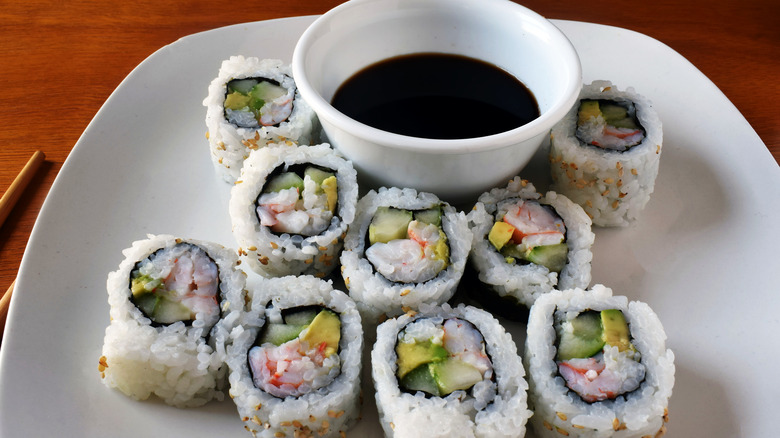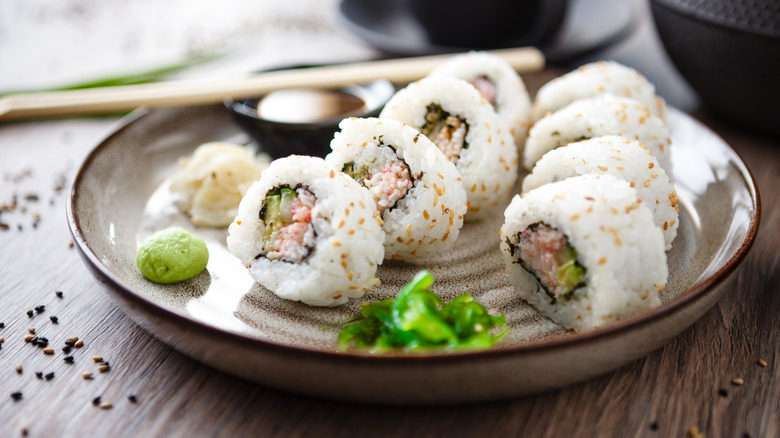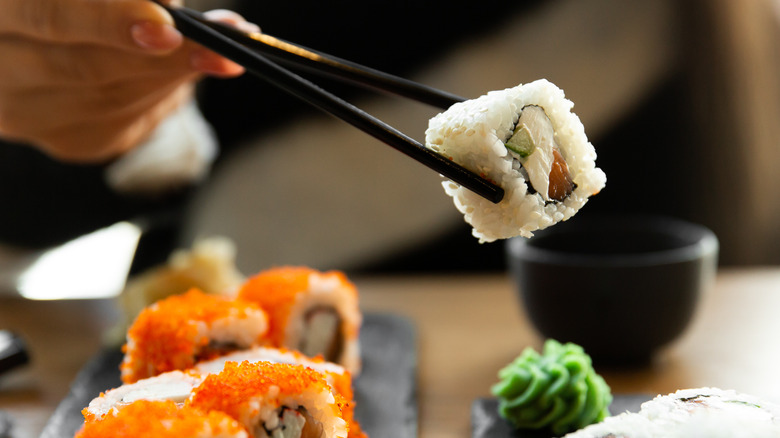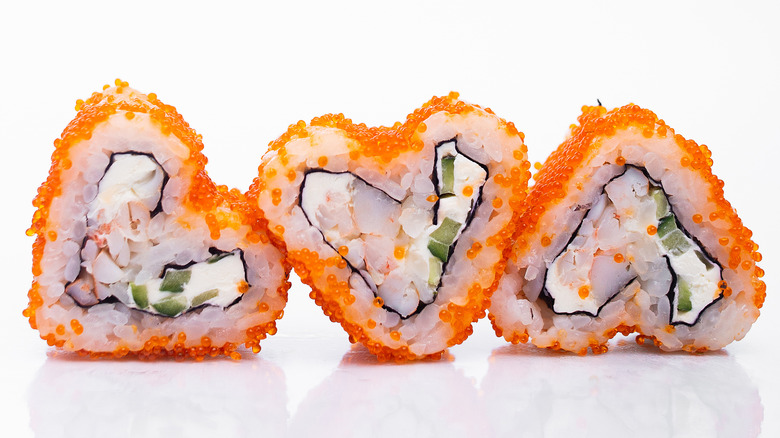California Roll: What You Should Know Before Ordering
The California roll is a popular type of sushi in the U.S. that also has global appeal (via Britannica). As its name suggests, the California roll is not traditional Japanese fare. Like all sushi, however, its roots go back to feudal Japan, according to the website for the Colorado sushi restaurant Matsuhisa. That said, the first sushi was actually fish combined with rice and allowed to ferment for months at a time. The more familiar rolled makizushi, or maki, came in the early 18th century, according to Gurunavi – about the time that sheets of toasted seaweed called nori were developed.
As Matsuhisa tells the history of sushi, the most popular style for most of the past 200 years was nigiri, which is made by draping a piece of raw fish over a clump of rice (via Roka Akor). Makizushi, or sushi rolls, didn't hit their stride until the 1960s. With demand for sushi on the rise, chefs started rolling fish and rice into a nori-wrapped cylinder and slicing the cylinder into six to eight portions, as a more efficient alternative to nigiri. The California roll doesn't quite work like that, however. It was part of the next evolution of sushi.
What is California roll, and why was it added to sushi menus?
There are several kinds of sushi roll, from the little hosomaki, containing just seasoned rice and a single other ingredient, to the futomaki, big enough to hold four or more ingredients in addition to the rice and nori (via Matsuhisa). These types of sushi have the nori on the outside. The California roll, on the other hand, is inside-out — a type of sushi called uramaki in Japanese. The rice surrounds the nori, which in turn holds the rest of the ingredients.
As one version of California roll's origin story has it, chef Hidekazu Tojo invented it in Vancouver, Canada in the 1970s (via Insider). While today we think of California roll as imitation crab, avocado, and cucumber, Tojo filled his creation with fresh crab, avocado, spinach, and egg. He said he made changes to traditional sushi because his Canadian customers disliked both raw fish and seaweed. He got rid of the raw fish altogether, and he hid the seaweed inside the roll. He called his invention "inside-out" at the time, but Tojo said the Japanese media caught wind of it and called it "California roll."
To hear other versions of California rolls' history, they were maybe invented in California, after all. Two Los Angeles chefs figure in these stories, both working in the 1960s and both trying to accommodate Western tastes, according to Insider. One of these, chef Ichiro Mashita, substituted crab and avocado because he couldn't get good tuna in the U.S.
How do you eat California roll?
The fact that the California roll is served uramaki (inside-out) puts all that sticky, seasoned rice on the outside, just crying out to be covered with ... something. California rolls are often served with a sprinkle of sesame seeds over the exposed rice (via Shogun Japanese Steakhouse). Others are rolled in fish roe, often flying-fish eggs or tobiko (via NDTV Food), giving the senses yet another color and flavor to savor. Another variation is to set raw fish or a slice of avocado over a California roll, creating a rainbow roll (via International Cuisine).
For etiquette tips on how to eat California roll (or any sushi), Los Angeles Magazine says you may pick it up with your hands, but it is equally okay to use chopsticks as long you don't squeeze too hard. Now, open wide, because sushi is meant to be eaten in one bite.
If you use soy sauce, pour only a small amount in a dish, and dip your sushi into it lightly. Do not, we repeat, do NOT put wasabi in it. (That should be dabbed directly on the sushi.) In between bites, enjoy a slice of pickled ginger. Do not put the pickled ginger directly on your California roll. Finally, eat up, because it's considered impolite to leave food on your plate — even a single grain of rice could cause your sushi chef agita.
Before ordering California roll, consider the nutrition facts
When it comes to California roll, registered dietician Jill Corleone approves. "As with most sushi, when it comes to nutrition, the California roll is low in calories and high in healthy fats," Corleone wrote for Livestrong. One full California roll, which might be cut into eight pieces before serving, contains 255 calories. The 7 grams of fat in this much California roll is mostly from the avocado, which is mostly healthy, monounsaturated fat. You'll also get 9 grams of protein from a California roll made with imitation crab meat, which is actually fish — Pacific whiting or pollack.
Another nice thing about California roll, at least in terms of health, is that it's considered generally safe for those who are pregnant, according to Healthline. Pregnant people should avoid spicy tuna roll or any other type of sushi that includes raw fish, due to the risk of exposure to bacteria, parasites, and mercury. California roll, on the other hand, contains cooked fish known to have safe mercury levels.



